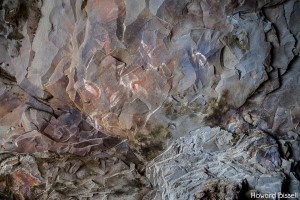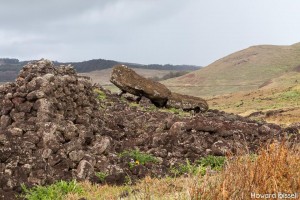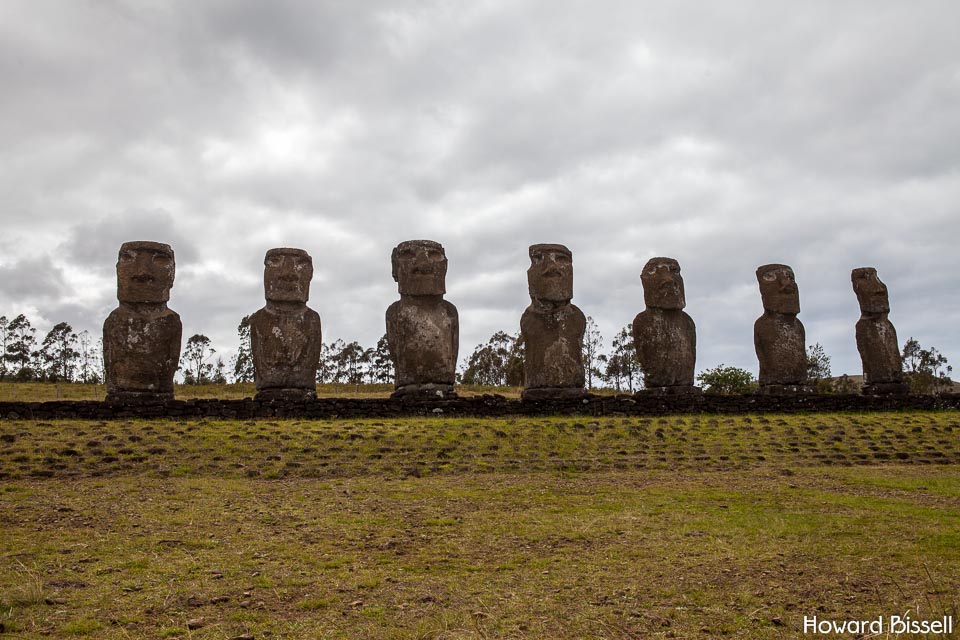My sleep was disturbed last night by the outside light on our patio. I have the perfect fix! I will unscrew it. (And I did!)
For some reason we have gotten the actual time here all messed up. We’ve been traveling in and out of time zones and are thoroughly confused. So we wake up an up hour earlier than we had planned but we’ve had plenty of sleep so we look at the internet news and head off to breakfast about 8am.
We have a GREAT breakfast! My fave is crepes filled with a sweet syrup. In addition there are sweet breads, meats, cheese, avocado, delicious sliced tomatoes, fresh Chilean rolls, great fruit salad, 2 nice juices and good coffee.
After breakfast we visit the national park headquarters to get a map and ask for advice on where to go. First stop is Ana Kai Tangata, a shallow ocean cave with bird paintings (representations of the Sooty Terns that nest here) dating to about 1900. It actually takes us a little while to decide if those dim splashes of color are the paintings we’re supposed to see. It’s only later when we see a picture of the paintings in a guide book that we confirm what we saw.
It’s only later when we see a picture of the paintings in a guide book that we confirm what we saw.
We then drive to Ahu Akivi, a platform of 7 statues (called Moais) on a hill facing the ocean. This site was restored by William Mulloy in 1960; it was the very first restoration of the Moais. This group of standing Moais are on the top of a hill. Most of the statues are along the coast facing away from the ocean so this is unique. The Moais, tributes to deceased chiefs or important elders, apparently were erected to look over and protect the village. The platforms of the Moais contain the remains of those important people. These Moais do in fact look over the ruins of a village but they also appear to have astronomical purposes; the platform is aligned with the spring and autumn equinoxes.
At some time in the history of the island the native people, either because of interfamily/tribe conflict or because of a loss of faith in their gods, knocked over every single Moai that had been installed on a platform (called an Ahu) onto its face (to stop its power). The year 1838 was the last year an upright Moai was seen. So most Moais, even if restored to an upright position, have been broken and mended. But throughout the island, most Moais are found face down on the ground around the Ahus. It’s really quite sad! After the completion of the restoration of Ahu Tongariki in 1996, and after the naming of Easter Island as an UNESCO site, only archeological preventative maintenance has been carried out on the statues. No other statues will be restored to the upright position.
(to stop its power). The year 1838 was the last year an upright Moai was seen. So most Moais, even if restored to an upright position, have been broken and mended. But throughout the island, most Moais are found face down on the ground around the Ahus. It’s really quite sad! After the completion of the restoration of Ahu Tongariki in 1996, and after the naming of Easter Island as an UNESCO site, only archeological preventative maintenance has been carried out on the statues. No other statues will be restored to the upright position.
More island history: It is thought that the original settlers of the island back in approx 700 AD to 1,200 AD, traveled 2,000 miles from another Polynesian island to begin a new life on Easter Island (or Rapa Nui, as the native people call it). They brought plants and animals with them including Pacific Rats (apparently for food). By about 1700 the population had substantially decreased and the island was essentially deforested. There are many theories about the demise of the native population including deforestation by slash and burn methods for farming; tree seeds eaten by a huge overpopulation of Pacific Rats; and European influences including disease and slavery. In 1877 there were a mere 110 native people on the island and by the early 1900s the island was overrun with sheep for commercial purposes and the native people were confined to a very small part of the island.
We drive a short distance and take a hike to find a lava-tube cave. It takes a bit of hunting but we find it. The cave has a large opening on the “roof.”The native people used these cave openings to grow crops; we see banana and avocado trees. It was a good place for shelter from the environment and water is more easily collected.
We have ham and cheese empanadas for lunch at Cafe Ra’a. They are much better than the empanadas in San Pedro. I try Crystal beer, a Chilean beer, and like it very much.
Rex hires a local guide for the afternoon. His name is Frieder but we are all confused about his name and I call him “Frieda” about a thousand times. Hopefully he thinks I have a speech impediment.
Frieder is no Cris; he is quiet and reserved but as the afternoon goes on he opens up. He takes us to Rano Raraku, the quarry for the Moais. The native people used the rocks of this 500 ft mountain (rocks called tuff which is consolidated volcanic ash) for the Moais. This is a dormant volcano and we first hike to the crater lake. There are a few Moais on the inside of the crater walls (it is thought that these are practice Moais) but the bigger Moais population is on the outside slopes of the mountain.
On the slopes you are able to see Moais is every state of completion! Some have just been outlined in the quarry rock; some are ready to be removed in full form; many have been moved down the mountain and are at different elevations. There are many buried Moais; it is estimated that there are 1,000 Moais on the island. There are a couple interesting features on the figures. The hands carved on the Moais have VERY long fingers. It is thought that the chiefs had very long finger nails and the long fingers represent that feature. Also the figures have ears that appear to represent the cultural feature of enlarged earlobes–as long as to the shoulders. You know, like those stupid kids today!
There are many buried Moais; it is estimated that there are 1,000 Moais on the island. There are a couple interesting features on the figures. The hands carved on the Moais have VERY long fingers. It is thought that the chiefs had very long finger nails and the long fingers represent that feature. Also the figures have ears that appear to represent the cultural feature of enlarged earlobes–as long as to the shoulders. You know, like those stupid kids today!
After completion, the Moais were moved down the mountain and onto roads with routes to their final destination. The Moais have been described as “walking” to their ultimate destination. It has been proved that these large statues can be rocked back and forth on their base (rather like walking) and moved more quickly than you’d imagine. At their final destination they are mounted on the platform, the eyes sockets are fully carved out and the eyes are put in place (eyes made of coral with red lava irises). Only then is the Moais alive.
Around the island and in the island’s museum you can see a few different figure types although the iconic angular form is the most prevalent. It is thought that the earlier forms may be female and have much more rounded heads and, in one case, show legs in a sitting position.
I see a cute little partridge-like bird and Frieder says it’s a wee-wee bird. He says they scare easily and I ask “Do they then wee-wee?” I don’t think he gets the joke (like Cris would) and he simply says their call is “wee-wee.” He proceeds to walk through the tall grass to scare one up and when it “wee-wees” it nearly scares us to death, it’s so sudden and loud.
We take a short drive to the most amazing Ahu on the island, Ahu Tongariki. This ceremonial Ahu has 15 colossal restored Moais including one with an amazing red topnot. This site was destroyed by the 1960 earthquake (9.5 on the Richtor scale) and resulting tsunami. It was restored in 1996. We vow to come back for sunrise pictures here.
On the way back to the hotel we stop at the grocery store and I buy premade Pisco Sours in a bottle. (Thankfully we have a small refrigerator in the room.) Rex buys more chocolate. What a great combination! We enjoy the premade Pisco Sours at cocktail hour–not bad at all!
We have a GREAT dinner at Kaleta right on the water. The sunset is amazing! We all have fresh white fish, mashed sweet potatoes and what we thought was a lobster sauce but our server said was a rosemary sauce. A nice Chilean Sauvignon Blanc wine is the perfect pairing. For dessert we share profiteroles–small creme puffs stuffed with ice cream and covered with chocolate. These were not the best we’ve had, unfortunately. They were infused with a weird tasting liquor. But all in all it was a wonderful evening.
On way home in the dark I come close to walking into an open storm drain! It is about 2 feet deep. Howard saves me, thank goodness. A fall like that would have done my poor knee in.
